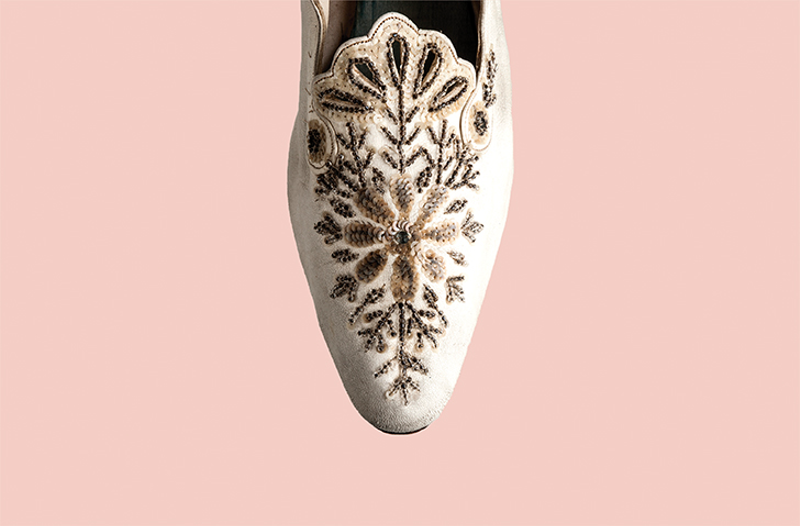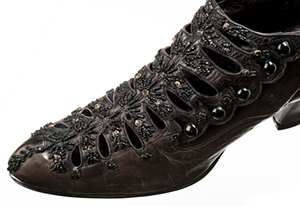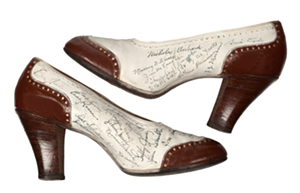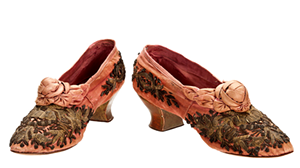
The upcoming Taft Museum of Art exhibition Walk This Way is as much a showcase of improbability as it is a collection of historical shoes. Shoes haven’t always been made to last — not for a decade, and certainly not for hundreds of years. But some do, which leads to the coincidental way the exhibition’s 100-plus pairs came together.
“It was started by accident,” says Stuart Weitzman, prolific shoe designer and owner of the collection. “My wife would buy me an appropriate gift at birthday time or for Valentine’s Day, like I would do for her, and I generally would return them because either they were too small or I didn’t like them. After about six ties, I decided to convince her I don’t wear ties. So the next few, she bought an antique shoe, and that was great.”
One shoe turned to many, many more, including early-1800s satin wedding shoes, silk boudoir shoes created for the 1867 International Exposition in Paris, and 1940s leather and suede pumps signed by the New York Yankees (an odd yet amazing entry, even for this exhibition).
“At every occasion, when a gift might be appropriate, she found another antique shoe,” Weitzman says. “Then we both started filling them in with wonderful pieces, and that’s how the collection happened — started by accident, and then it became quite serious.”
Jane Gershon Weitzman’s gift-turned-family collection, since organized by the New-York Historical Society, opens as an exhibition at Taft’s Fifth Third Gallery on Feb. 27.
“For me, it’s a very multi-layered exhibition,” says Ann Glasscock, assistant curator at the Taft Museum of Art. “There’s really a focus on women’s contributions as makers, buyers, designers, and entrepreneurs. I think visitors will be both very happy with the shoes that they see and also pleasantly surprised by the rich and perhaps unexpected stories that we tell throughout the exhibition.”
After all, a shoe isn’t just a shoe, particularly when it’s one of the vintage or antique pieces from the collection’s nearly 200-year span.
In showcasing these shoes, the museum invites guests to imagine the stories of those who walked in them, cared for them, and lived their lives wearing them, whether it’s a pair by Christian Dior, Yves Saint Laurent, or, yes, Stuart Weitzman.

“There are a lot of great shoes in the exhibition that tell these stories,” Glasscock tells CityBeat. “Guests will see shoes that suffragists would’ve worn as they marched through the streets. There are these leather, high-button boots, spectator pumps, lace up shoes — the types of shoes that those women would’ve worn in the early 1900s. Within our presentation section, there is a section on suffrage, so that’s more of the multiple layers that we’re getting into here.”
With each layer peeled back, there’s something more to be seen, and the stories become more defined.
“In terms of labor activism, we have a beautiful black beaded shoe that has the stamp of the shoemaker’s union on the bottom, and that gives us a chance to tell all these stories about women who were active in trade unions, like the Daughters of St. Crispin or the International Boot & Shoe Workers Union, and how they really participated in strikes to protest low wages and poor treatment,” Glasscock continues. “This was kind of radical for its time, for women. And so for that single shoe — that black, beaded shoe — it gives us a chance to tell that story.”
“And there’s some other great shoes by female designers, because our industry was not an opportunity for female designers, even though we were making shoes for ladies,” adds Weitzman. “Eventually, two or three women became very renowned in footwear. We have shoes in the collection by Margaret Jerrold, who was maybe the first one who made a big mark. She was an American manufacturer — her husband actually was the shoemaker — and Beth Levine is the other.” (Glasscock notes that the exhibition will have a pair by Edouard Jerrold, Inc., specifically.)
Beyond history on women’s labor activism, suffrage, and the sexual revolution — all told through shoes and all detailed throughout the exhibition — Glasscock and team dig deeper into shoe-specific narratives via Taft’s “More To The Story” labels, a newer addition to the museum’s traditional labeling system.
“These labels really help tell stories about underrepresented or misrepresented people throughout history,” Glasscock explains, noting that there are 10 “More To The Story” labels “sprinkled throughout” the Walk This Way exhibition. Find them, and you’ll find a snapshot worth seeing: red, thigh-high boots from the musical Kinky Boots give way to the history of the first drag queen, who Glasscock says lived in Washington D.C. in the late 1800s. The pumps signed by the Yankees lead to a discussion about the color barrier in baseball.

“These labels are really wonderful in that they allow us to take a deeper dive into different and perhaps unexpected avenues throughout history,” Glasscock adds.
That said, there are shoes in the exhibition that remain personal to the Weitzman family, regardless of their connection to broader moments in time.
“There’s a shoe that was created by my father, and it’s an example of his talent. Some of it I suppose kind of rubbed off on me,” Weitzman says, referring to his father and fellow shoemaker Seymour Weitzman.
“We were at an event at Nordstrom in Seattle, where our company was being awarded for the business that we generated together, and my wife went out shopping with my two kids in Seattle, sort of a cool town then, and found a pair of shoes in a box.”
Another odds-defying stroke of fate: it was a Seymour Weitzman box, with midcentury Seymour Weitzman-brand shoes inside of it.
“I had never seen that shoe, and she gave it to me — it’s a beautiful, spike heel, pointed toe, lace-up, but a very sexy lace-up. It’s a play on a shoe that’s traditionally a low heel, an Oxford- type shoe, and is made into a very high heel,” Weitzman says. “It’s not the kind of design that I saw throughout my career, it just isn’t. I don’t know why, because it really is very, very sexy, with a very dipped side. Before the ribbon wore out, it was laced with a beautiful silk satin ribbon. And of course, with that toe, and that heel! He made it look great, he did a good job with that one.”
As it turns out, excelling at shoe design runs in the family. Weitzman says that while he worked a few summers with his father and older brother at a factory his dad had set up, his career-defining moment arrived by way of a friend, whose father also owned a shoe factory.
“He saw how nicely I drew, and he said, ‘My dad doesn’t design shoes, he buys ideas from the outside. He has his own factories. He’s a good shoemaker, and that’s how he creates his collections. Maybe he’ll buy something from you,’” Weitzman recalls.
“And sure enough, he did. He bought 19 sketches from me the first time I met him,” Weitzman continues. “And I’ll tell you, I didn’t know what I was gonna even suggest as the price. He says, ‘I’ll give you 20 bucks a sketch.’ That was $380, and my tuition at the Wharton School was $3,700. And those sketches took me less than an hour. I mean, I’d just made 10% of my tuition, and wow, maybe I ought to try this for a living.”
So then, how does something like a shoe — inconsequential to some, a fashion statement to others — become museum-worthy art, something that would be featured in a traveling exhibition? It’s a broad-strokes question often pondered by the fashion community at large, like how a piece becomes a political statement, or how something you wear now might connect to the larger fluctuations of history.
Sometimes, these latter two are easier to spot. Weitzman points to the high-button shoes often associated with the Victorian era.
“1915 to [19]20, women’s dresses started to rise. Maybe it was practicality — they wanted to keep the edges clean — and they were being more liberalized, so they were doing things on their own and men weren’t, like, carrying them over a puddle, so to speak,” Weitzman says. “And it created a real moral crisis with their families because their ankles were now showing. The high button shoe was made to allow you to wear a skirt, say, 12 inches above your ankle and not show any skin.”
But quantifying Art with a capital A is a bit trickier.
“I think a lot of things are exhibit-worthy. And if you have something that tells a good story, you’ve got a great start,” Glasscock says. “The wonderful thing about the shoes and boots and this exhibition is that they all tell stories. I also find that objects that are really well-made are art, in my opinion. For example, one of the first pairs of shoes that guests will encounter is a pair of silk boudoir shoes created especially for the 1867 Paris Universal exhibition. A skilled artisan made and embroidered this pair by hand, with this beautiful embroidery.”
“Some clothing is art. Downtown in the SoHo area of Manhattan, there was a great store called Wearable Art. Every piece was one of a kind. Every piece was unique. Some were beautifully done, some were outrageous, and some were ugly, but they were all very artistic,” adds Weitzman.
“Why can’t a consumer product be a work of art?” he asks. “It can. And many of them end up in the Smithsonian or other museums in Washington as examples of the perfect design. There’s a fountain pen that Elsa Peretti created that you’d want to wear in your shirt pocket just to show off the top half of the pen. Listen, a lot of people paint, a lot of it becomes good art, most of it doesn’t. The same thing with consumer product.”
But... why shoes? Why not paintings, or pens, or any other type of products?
Weitzman brings up the movie Forrest Gump. After pointing out that “Life is like a box of chocolates” is, of course, the most famous quote, Weitzman notes one he found “equally as prophetic” from the title character.

“He was sitting on that bench, waiting to go see Jenny, waiting for the bus with that lady next to him. And a man was walking by, and he spotted this man, maybe 100 feet to his right. And he never took his eyes off his feet. The man passed him, and continued up the road. And the woman said to him, ‘Forrest, why were you watching that man’s feet?’ And he said, ‘Oh, my mama told me that you can tell a lot about a person by their shoes, where they’ve been and where they’re going,’” recalls Weitzman. “I always felt that about footwear, and it intrigued me to be able to create product that a woman could use to make herself a little bit who she wasn’t for a little bit of time of the day or night.”
Ultimately, visitors get to be the judge of it all — the art, the politics, and the shoes — when they experience Walk This Way. And the curators share that coordinating, opening, and showing an exhibition during a global pandemic is defying many odds.
“Because of COVID, capacity is limited at the exhibition, so we do require guests to purchase their tickets in advance, at least until further notice,” notes Glasscock. Beyond abiding by health and safety protocols for in-person guests — safety guidelines are available on the museum’s website — the Taft is stepping into the digital arena with virtual museum tours and programming tied to the exhibition.
“We’re definitely doing everything we can to get people involved and make sure that everyone’s safe,” Glasscock says.
It’s well worth a visit, either in person or through one of the virtual avenues. When talking to Weitzman and Glasscock, one is reminded how miraculous it is that these historical pieces have survived through decades of genuine wear and tear:
“Footwear has a tendency to self-destruct over a certain number of years. Not like paintings that are protected or sculptures that are forever,” Weitzman says. “And what you will see when the exhibition opens is that life’s work.”
Walk This Way opens Feb. 27 and runs through June 6. Learn more at taftmuseum.org.





